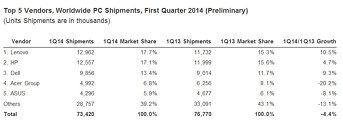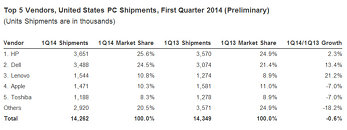- Joined
- Dec 6, 2011
- Messages
- 4,784 (1.01/day)
- Location
- Still on the East Side
Worldwide PC shipments totaled 73.4 million units in the first quarter of 2014 (1Q14), a decline of -4.4% year-on-year, according to the International Data Corporation (IDC) Worldwide Quarterly PC Tracker. Although still in decline and with continuing weakness in consumer and emerging market segments, the preliminary results are slightly better than a projected decline of -5.3%.
Similar to the latter part of 2013, the upside in the first quarter arose primarily from demand in mature commercial markets. Commercial refresh projects, which had already been protracted, received a last push from the impending end of Windows XP support, particularly in Japan. In addition, slowing demand for tablets seems to have helped constrain previously drastic cutbacks in notebooks. Nevertheless, emerging regions continued to post weak results, with growth in Latin America and Asia/Pacific (excluding Japan)(APeJ) falling even faster than recent declines as both economic conditions and continued tablet penetration stifled PC shipments.


"Worldwide PC shipments have now declined for eight consecutive quarters as a result of shifting technology usage and competition (notably with tablets & smartphones) as well as economic pressures (including high unemployment, slow growth & investment, tight credit, and currency fluctuations) related to the Great Recession, sovereign debt crises, and their related impact on international trade," said Loren Loverde, Vice President, Worldwide PC Trackers. "The economic front seems to be gradually stabilizing and/or improving. However, this has been a slow process, and it is unlikely that sovereign debt issues will be resolved soon or that growth in emerging markets like China will return to prior levels. On the technology front, the transition to more mobile devices and usage modes is unlikely to stop, although the short term impact on PC shipments may slow as tablet penetration rises - as we've begun to see in some mature regions. The net result remains consistent with our past forecasts - in particular, that there is potential for PC shipments to stabilize, but not much opportunity for growth."
"PC shipment growth in the United States remained slightly faster than most other regions in the first quarter. However, the passing boost from XP replacements, constrained consumer demand, and no clear driver of a market rebound are expected to keep growth below zero going forward," said Rajani Singh, Senior Research Analyst, Personal Computing. "A rebound in consumer or a continuation of accelerated commercial upgrades could boost growth slightly, but low demand for upgrades in general combined with competition from tablets and 2-in-1 systems limit the growth potential."
Regional Highlights
United States - The U.S. market continued to stabilize with growth near zero - in line with forecasts. With shipments totaling 14.3 million PCs in 1Q14, the U.S. market contracted by -0.6% from the same quarter a year ago. Desktop shipments were slightly stronger, posting 3.5% growth, while portables remained in negative territory.
EMEA - The PC market in EMEA returned to more stable levels and performed above expectations, with shipments supported by healthy demand in the commercial space, where end of Windows XP support and improving macro-economic outlook led to stronger than anticipated sell-in across a number of countries. The consumer market started to stabilize, showing signs of improvement; however shipments remained within negative trends. Performance in some mature markets appears to have been more positive than expected, with growth enhanced particularly by corporate renewals, while the business environment in the emerging economies proved difficult, with shipments affected by currency fluctuations and high inventory in certain countries.
Japan - The scale of commercial refresh remained remarkably strong, helping Japan achieve yet another double-digit growth quarter. Consumer volume was also good due to the last minute surge in demand before the VAT increase in April. All major vendors saw sizable growth and Japan shipments rose to more than 7% of worldwide PC volume - the highest since early 2006.
Asia/Pacific (excluding Japan) - Most markets continued to struggle with lackluster demand and cautious channel intake. Inventory remains higher than ideal for most vendors, although pockets of retail are showing signs of mild pick up. Although shipments were close to forecast, growth declined by double digits, marking a full two years of shipment declines for APeJ.
Vendor Highlights
Lenovo preserved its lead in total worldwide PC shipments despite a seasonal drop due to the Chinese New Year. Growth in other regions continued at a solid pace although Latin America slowed after a dramatic expansion over the past year.
HP remained in the number 2 position, with growth rising nicely to nearly 5% year on year, the company's highest growth in more than two years. Strong results in EMEA had the largest impact on HP's results, although growth in the U.S. and Canada also improved notably.
Dell grew over 9% in the first quarter, its highest rate since 4Q11 and the third consecutive quarter of positive year-on-year growth. The vendor's revamped channel strategy - with greater focus on partners and solutions as well as use of PC sales as part of broader solutions - Is paying dividends as the company benefits from the relative strength of commercial replacements as well as operational freedom and reduced uncertainty after completing the privatization.
Acer continues to work on stabilizing PC shipments. Fourth quarter growth turned up nicely, but first quarter results slipped again. Slow consumer demand, competition from other players, and a shift in product portfolio towards 2-in-1 and tablets all contributed to the slower PC results.
ASUS growth slipped notably in the U.S., but follows a relatively strong fourth quarter. The company is in a challenging spot - working to expand regional coverage with a consumer focus when emerging regions and consumers are slow parts of the market. Even so, the company grew faster than the market in EMEA and APeJ (its two largest markets) and saw strong gains in Latin America.
View at TechPowerUp Main Site
Similar to the latter part of 2013, the upside in the first quarter arose primarily from demand in mature commercial markets. Commercial refresh projects, which had already been protracted, received a last push from the impending end of Windows XP support, particularly in Japan. In addition, slowing demand for tablets seems to have helped constrain previously drastic cutbacks in notebooks. Nevertheless, emerging regions continued to post weak results, with growth in Latin America and Asia/Pacific (excluding Japan)(APeJ) falling even faster than recent declines as both economic conditions and continued tablet penetration stifled PC shipments.


"Worldwide PC shipments have now declined for eight consecutive quarters as a result of shifting technology usage and competition (notably with tablets & smartphones) as well as economic pressures (including high unemployment, slow growth & investment, tight credit, and currency fluctuations) related to the Great Recession, sovereign debt crises, and their related impact on international trade," said Loren Loverde, Vice President, Worldwide PC Trackers. "The economic front seems to be gradually stabilizing and/or improving. However, this has been a slow process, and it is unlikely that sovereign debt issues will be resolved soon or that growth in emerging markets like China will return to prior levels. On the technology front, the transition to more mobile devices and usage modes is unlikely to stop, although the short term impact on PC shipments may slow as tablet penetration rises - as we've begun to see in some mature regions. The net result remains consistent with our past forecasts - in particular, that there is potential for PC shipments to stabilize, but not much opportunity for growth."
"PC shipment growth in the United States remained slightly faster than most other regions in the first quarter. However, the passing boost from XP replacements, constrained consumer demand, and no clear driver of a market rebound are expected to keep growth below zero going forward," said Rajani Singh, Senior Research Analyst, Personal Computing. "A rebound in consumer or a continuation of accelerated commercial upgrades could boost growth slightly, but low demand for upgrades in general combined with competition from tablets and 2-in-1 systems limit the growth potential."
Regional Highlights
United States - The U.S. market continued to stabilize with growth near zero - in line with forecasts. With shipments totaling 14.3 million PCs in 1Q14, the U.S. market contracted by -0.6% from the same quarter a year ago. Desktop shipments were slightly stronger, posting 3.5% growth, while portables remained in negative territory.
EMEA - The PC market in EMEA returned to more stable levels and performed above expectations, with shipments supported by healthy demand in the commercial space, where end of Windows XP support and improving macro-economic outlook led to stronger than anticipated sell-in across a number of countries. The consumer market started to stabilize, showing signs of improvement; however shipments remained within negative trends. Performance in some mature markets appears to have been more positive than expected, with growth enhanced particularly by corporate renewals, while the business environment in the emerging economies proved difficult, with shipments affected by currency fluctuations and high inventory in certain countries.
Japan - The scale of commercial refresh remained remarkably strong, helping Japan achieve yet another double-digit growth quarter. Consumer volume was also good due to the last minute surge in demand before the VAT increase in April. All major vendors saw sizable growth and Japan shipments rose to more than 7% of worldwide PC volume - the highest since early 2006.
Asia/Pacific (excluding Japan) - Most markets continued to struggle with lackluster demand and cautious channel intake. Inventory remains higher than ideal for most vendors, although pockets of retail are showing signs of mild pick up. Although shipments were close to forecast, growth declined by double digits, marking a full two years of shipment declines for APeJ.
Vendor Highlights
Lenovo preserved its lead in total worldwide PC shipments despite a seasonal drop due to the Chinese New Year. Growth in other regions continued at a solid pace although Latin America slowed after a dramatic expansion over the past year.
HP remained in the number 2 position, with growth rising nicely to nearly 5% year on year, the company's highest growth in more than two years. Strong results in EMEA had the largest impact on HP's results, although growth in the U.S. and Canada also improved notably.
Dell grew over 9% in the first quarter, its highest rate since 4Q11 and the third consecutive quarter of positive year-on-year growth. The vendor's revamped channel strategy - with greater focus on partners and solutions as well as use of PC sales as part of broader solutions - Is paying dividends as the company benefits from the relative strength of commercial replacements as well as operational freedom and reduced uncertainty after completing the privatization.
Acer continues to work on stabilizing PC shipments. Fourth quarter growth turned up nicely, but first quarter results slipped again. Slow consumer demand, competition from other players, and a shift in product portfolio towards 2-in-1 and tablets all contributed to the slower PC results.
ASUS growth slipped notably in the U.S., but follows a relatively strong fourth quarter. The company is in a challenging spot - working to expand regional coverage with a consumer focus when emerging regions and consumers are slow parts of the market. Even so, the company grew faster than the market in EMEA and APeJ (its two largest markets) and saw strong gains in Latin America.
View at TechPowerUp Main Site





